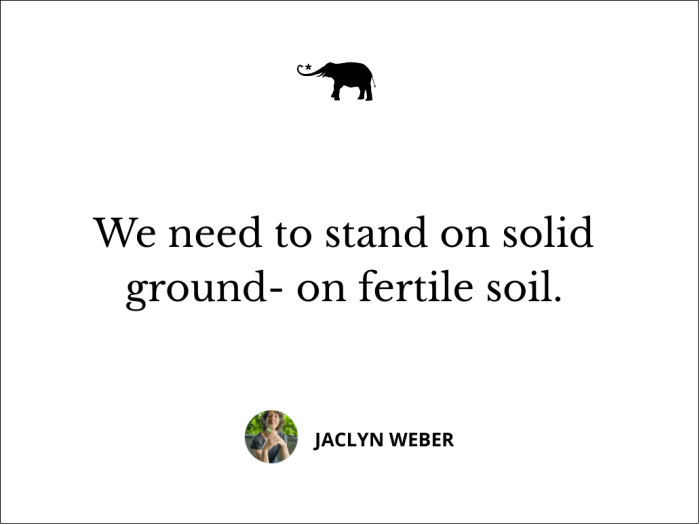I think a great deal about community and what it means to belong to each other. In my daily interaction with classrooms full of teens, I find that disconnection seems our most prevalent theme– a theme that carries a firestorm of psychological impacts. I have been in the teaching profession for twenty years now, and I have witnessed a change in our young people that can only be defined as a catastrophic disconnection.
Over the years, as society has moved further and further in-doors, in front of screens, and away from time in nature, there has formed a torrential tear in the psyche of humanity. The prevalence of depression, anxiety, autoimmune disorders, ADHD, etc., is climbing exponentially. I get that as we progress in our understandings of the human brain and its complex networking, we understand many ailments not previously named. However, the exponential increase goes beyond this.
What is terribly sad– is that we know that there is a non-pharmaceutical medicine for much of what we suffer. This medicine is not only an alternative path, but a path that does not threaten side effects from improper dosage, nor damage to the psyche. The repeated answer to this firestorm of ailments is time in nature. We need to stand on solid ground- on fertile soil. The research abounds that time spent in nature reduces most of these common neurological issues and offers a plethora of medicine that will benefit all, including our ravaged planet.
There are substantial studies that indicate many positive mental and physical benefits that occur when we are exposed to and immersed in nature and green spaces. Researchers in Denmark examined data from more than 900,000 residents born between 1985 and 2003 and found that children who lived in neighborhoods with more green space had a reduced risk of many psychiatric disorders later in life, including depression, mood disorders, schizophrenia, eating disorders, and substance use disorder. For those with the lowest levels of green space exposure during childhood, the risk of developing mental illness was 55% higher than for those who grew up with abundant green space (Engemann, K., et al., PNAS, Vol. 116, No. 11, 2019). This study is not alone in its findings. The scholarly articles in reputable science journals are piling up in the direction of necessity for time in the wild. Not only because it significantly reduces clinical disorders, but also for our general well-being. Time in nature reduces even the common day-to-day stress in life through positive impacts on our central nervous system and our brain’s natural dopamine release. It increases our happiness levels and general positive thought processing. If we could all get a proper dose of nature’s medicine, we would be a whole new people.
Notwithstanding, if we all spend adequate time connecting to nature, we might stand a chance to deepen our respect for nature. One of the most detrimental mindsets that we as humans carry is our notion that the Earth and nature belong to us, and that our planet is an infinite resource for our taking. It is this mindset that has propelled us into our larger-than-life climate catastrophe that we are currently neck-deep within. We do have the tools to fix this catastrophe- the solution is the ground beneath our feet. If you do not know of what I speak of, please visit https://kisstheground.com/ and educate yourself! Even if we can call off this looming climate catastrophe, in order to sustain ourselves far into the future, we are going to need a renewed respect for planet and nature. That respect comes fairly easily when we simply spend time within, or rather– time out(side). If we can make time to connect to place, to the natural world around us, to teach our children that this is a necessity and not simply an option, then perhaps we can save ourselves and our planet.
As a teacher, I am watching our children suffer. As a human, I am watching our planet suffer. And all the while- there has been this incredibly simple solution to all these complex problems. We can preach this message in the media; we can ask parents to buy in and raise their children with this knowing. However, the scope must be wider. We know how media and media messages work– they capture the attention of like-minded individuals already on board. I cannot help but think, as education is compulsory in most counties, that a shift in our curriculum and school systems might be the only sure pathway to a better world for all. We already know it is time to overhaul our rusty, old education system that was created for an industrial (factory-based) society and is still saturated with the inequities of a dominator-supreme culture. Perhaps it is time for schools to stop preaching global competition. Perhaps it is time for us to teach the absolute necessity of earth care, of nature connection, and of community. Perhaps it is time for schools to opt outside.
Environmental Neuroscience
Berman, M.G., et al., American Psychologist, 2019
Nature and Mental Health: An Ecosystem Service Perspective
Bratman, G.N., et al., Science Advances, 2019
Ecotherapy: Theory, Research and Practice
Jordan, M., & Hinds, J. (Eds.), Red Globe Press, 2016
Kiss the Ground, 501 (c)(3) Nonprofit. Los Angeles, California
https://kisstheground.com/
Ready to join?
Hey, thanks so much for reading! Elephant offers 1 article every month for free.
If you want more, grab a subscription for unlimited reads for $5/year (normally, it's $108/year, and the discount ends soon).
And clearly you appreciate mindfulness with a sense of humor and integrity! Why not join the Elephant community, become an Elephriend?
Your investment will help Elephant Journal invest in our editors and writers who promote your values to create the change you want to see in your world!
Already have an account? Log in.
Ready to join?
Hey, thanks so much for reading! Elephant offers 1 article every month for free.
If you want more, grab a subscription for unlimited reads for $5/year (normally, it's $108/year, and the discount ends soon).
And clearly you appreciate mindfulness with a sense of humor and integrity! Why not join the Elephant community, become an Elephriend?
Your investment will help Elephant Journal invest in our editors and writers who promote your values to create the change you want to see in your world!
Already have an account? Log in.
 Share on bsky
Share on bsky






Read 0 comments and reply